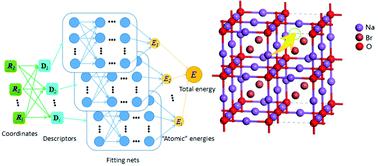当前位置:
X-MOL 学术
›
Inorg. Chem. Front.
›
论文详情
Our official English website, www.x-mol.net, welcomes your
feedback! (Note: you will need to create a separate account there.)
Theoretical study of Na+ transport in the solid-state electrolyte Na3OBr based on deep potential molecular dynamics
Inorganic Chemistry Frontiers ( IF 6.1 ) Pub Date : 2020-11-2 , DOI: 10.1039/d0qi00921k Han-Xiao Li 1, 2, 3, 4, 5 , Xu-Yuan Zhou 1, 2, 3, 4, 5 , Yue-Chao Wang 1, 2, 3, 4, 5 , Hong Jiang 1, 2, 3, 4, 5
Inorganic Chemistry Frontiers ( IF 6.1 ) Pub Date : 2020-11-2 , DOI: 10.1039/d0qi00921k Han-Xiao Li 1, 2, 3, 4, 5 , Xu-Yuan Zhou 1, 2, 3, 4, 5 , Yue-Chao Wang 1, 2, 3, 4, 5 , Hong Jiang 1, 2, 3, 4, 5
Affiliation

|
Recent discoveries in the antiperovskite-class sodium superionic conductors call for a thorough molecular dynamics (MD) study of sodium ion mobility, but the practical use of MD is often hindered by the accuracy-vs.-efficiency dilemma. Here we applied the recently developed deep potential molecular dynamics (DeePMD) approach to investigate the ion mobility in Na3OBr. With the deep potential model for Na3OBr constructed based on first-principles density-functional theory (DFT) calculations, we directly calculate the Na+ diffusion coefficient at various temperatures, and obtain an activation energy of 0.42–0.43 eV. This in comparison with the 0 K migration barrier (0.41–0.43 eV) suggests that the finite temperature effect is negligible for Na3OBr. The model gives an extrapolated room temperature ionic conductivity of 1 × 10−4–2 × 10−4 mS cm−1, roughly in the same order of magnitude as the experimental results. We also confirm the proportionality of the diffusion coefficient with respect to the vacancy concentration, and find that the migration barrier is relatively insensitive to the vacancy concentration. This work further demonstrates the promising role of the DeePMD method in the study of the transport properties of solid-state electrolytes.
中文翻译:

基于深势分子动力学的固体电解质Na3OBr中Na +迁移的理论研究
抗钙钛矿级钠超离子导体的最新发现要求对钠离子迁移率进行彻底的分子动力学(MD)研究,但MD的实际使用通常受到精度与效率困境的阻碍。在这里,我们应用了最新开发的深层潜在分子动力学(DeePMD)方法来研究Na 3 OBr中的离子迁移率。利用基于第一原理密度泛函理论(DFT)计算的Na 3 OBr深势模型,我们可以直接计算Na +在不同温度下的扩散系数,并获得0.42-0.43 eV的活化能。与0 K迁移势垒(0.41-0.43 eV)相比,Na 3 OBr的有限温度效应可以忽略不计。该模型给出的外推室温离子电导率为1×10 -4 –2×10 -4 mS cm -1,与实验结果的数量级大致相同。我们还确定了扩散系数与空位浓度的比例关系,并发现迁移势垒对空位浓度相对不敏感。这项工作进一步证明了DeePMD方法在固态电解质传输特性研究中的有希望的作用。
更新日期:2020-12-17
中文翻译:

基于深势分子动力学的固体电解质Na3OBr中Na +迁移的理论研究
抗钙钛矿级钠超离子导体的最新发现要求对钠离子迁移率进行彻底的分子动力学(MD)研究,但MD的实际使用通常受到精度与效率困境的阻碍。在这里,我们应用了最新开发的深层潜在分子动力学(DeePMD)方法来研究Na 3 OBr中的离子迁移率。利用基于第一原理密度泛函理论(DFT)计算的Na 3 OBr深势模型,我们可以直接计算Na +在不同温度下的扩散系数,并获得0.42-0.43 eV的活化能。与0 K迁移势垒(0.41-0.43 eV)相比,Na 3 OBr的有限温度效应可以忽略不计。该模型给出的外推室温离子电导率为1×10 -4 –2×10 -4 mS cm -1,与实验结果的数量级大致相同。我们还确定了扩散系数与空位浓度的比例关系,并发现迁移势垒对空位浓度相对不敏感。这项工作进一步证明了DeePMD方法在固态电解质传输特性研究中的有希望的作用。











































 京公网安备 11010802027423号
京公网安备 11010802027423号